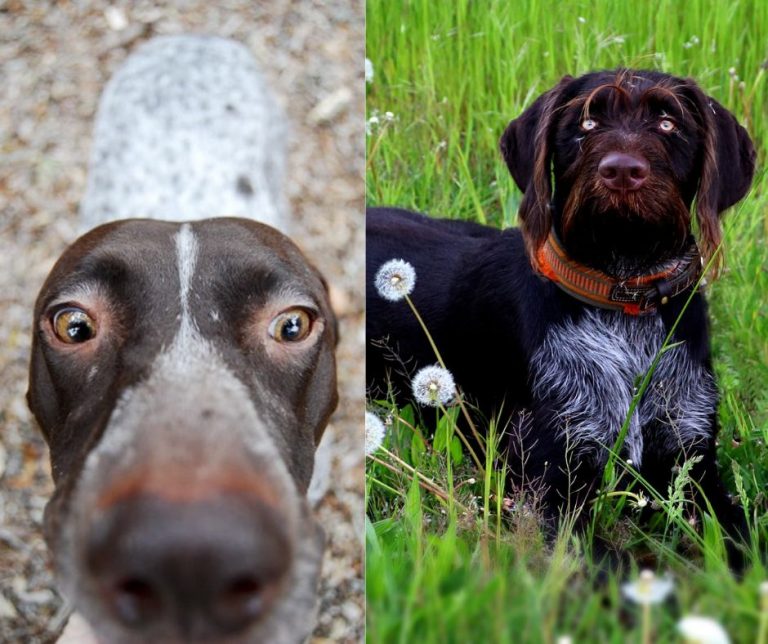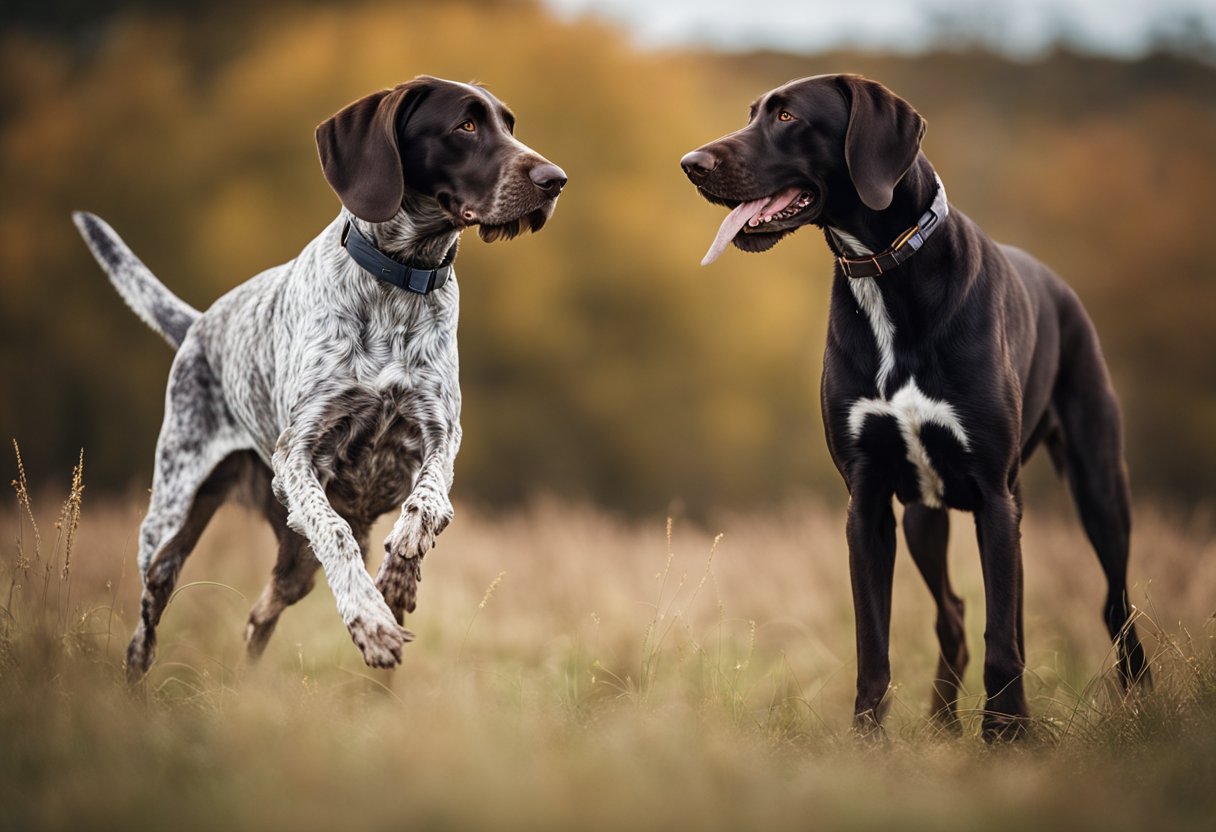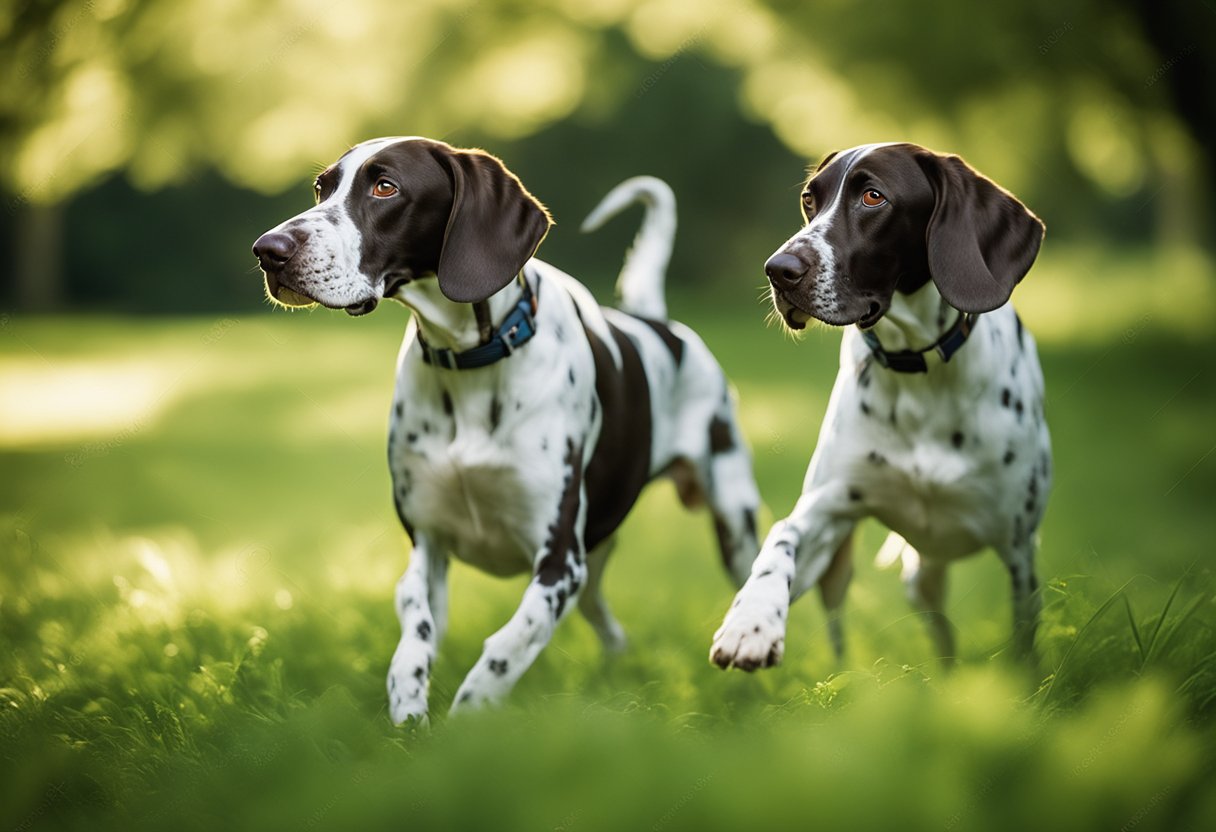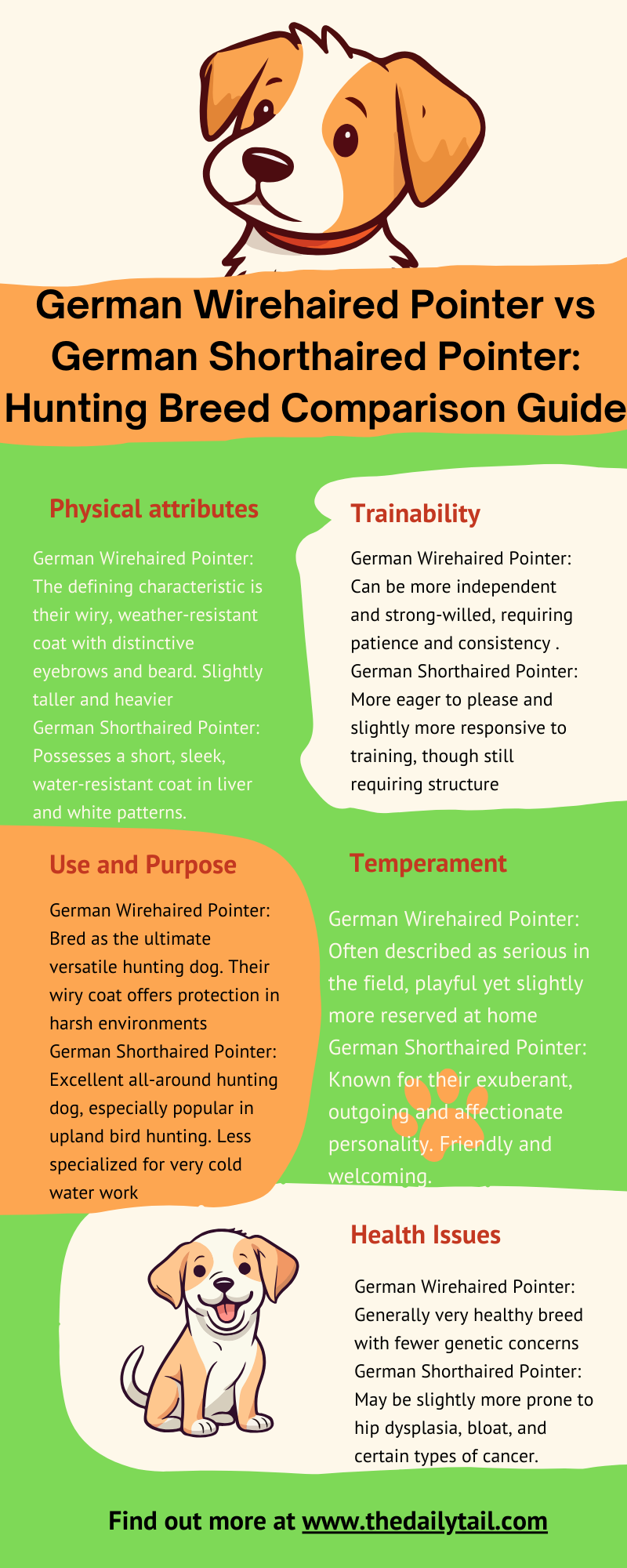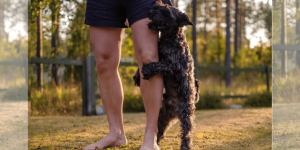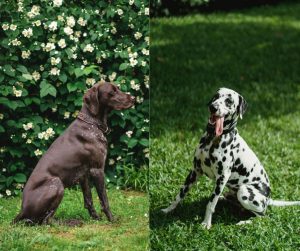The German Wirehaired Pointer and the German Shorthaired Pointer are two breeds that share a common heritage as versatile hunting dogs from Germany, yet they are distinct in their physical attributes and temperament. The Wirehaired Pointer is recognized for its rough, wiry coat which provides resistance to harsh weather, whereas the Shorthaired Pointer exhibits a smoother, shorter coat more suited to warmer conditions. Their differences are not merely cosmetic, as these variations influence their suitability to different hunting tasks and environments.
While both breeds are adaptable to family living and demonstrate a strong bond with their human companions, the German Wirehaired Pointer often presents with a more intense demeanor, particularly in working scenarios. The German Shorthaired Pointer, on the other hand, is often seen as mellower in a domestic setting, thriving in warmth and excelling at upland game hunting. Breed enthusiasts appreciate the steadfastness of the Wirehaired Pointer and the lively spirit of the Shorthaired Pointer, both in the field and as cherished pets.
When considering their roles as hunting companions, the Wirehaired Pointer is noted for its ability to tackle challenging terrains and cold environments, making it a preferred choice for waterfowling.
Conversely, the Shorthaired Pointer is reputed for its speed and agility, factors that give it an edge in pursuing game across upland terrains. Both breeds require ample exercise, mental stimulation, and dedicated training to channel their natural instincts and energy positively.
Imagine your two best friends: one always up for anything, the other a bit more reserved but fiercely loyal. That’s kind of like choosing between a German Wirehaired Pointer and a German Shorthaired Pointer. Even a seasoned dog owner like myself might mistake them sometimes. But there are more differences than the coat texture.
Breed Origins and History
The German Wirehaired Pointer and the German Shorthaired Pointer dog breed are both esteemed hunting breeds originated in Germany, with distinct characteristics in their coats and aptitudes. Their development was driven by the diverse hunting requirements in their country of origin.
Development in Germany
The German Shorthaired Pointer (GSP), known in Germany as the “Deutsch Kurzhaar,” traces its lineage to the mid-1800s. These dogs were bred to perform various hunting tasks, from pointing to retrieving, in a variety of terrains and weather conditions. The breed is thought to have arisen from a blend of old Spanish pointers and continental pointers, with additional bloodlines such as the German Bloodhound and French Gascon to refine their scenting skills.
Conversely, the German Wirehaired Pointer (GWP), also referred to in its homeland as “Deutsch Drahthaar,” began its development later, in the late 19th century. The breed was a result of meticulous breeding, with contributions from the Wirehaired Pointing Griffon, the German Shorthaired Pointer, the Pudelpointer, and other breeds like the Griffon and Stichelhaar. The objective was to create a versatile hunting dog with a wiry coat adept at navigating Germany’s dense cover and harsh conditions.
Historical Uses and Evolution
Historically, both breeds emerged as a response to the versatile hunting needs in Germany’s varied landscapes. The GSP was the all-rounder, capable of tracking and pointing upland game, retrieving waterfowl, and performing on both land and water with agility and endurance.
The GWP was fashioned with a similar versatile hunting role but with additional features. Its wiry coat and robust build made it particularly useful for braving the elements and the dense underbrush, proving it an indispensable companion for German hunters navigating tough terrains.
Over the years, these breeds have evolved, but their core functions as versatile hunting dogs remain integral to their identity. Their prowess is recognized and maintained by enthusiasts and breed clubs, including their respective parent clubs in Germany, which continue to oversee the breeds’ standards and breeding practices.
Breed Characteristics
In comparing the German Wirehaired Pointer and German Shorthaired Pointer, it is important to consider their distinct physical attributes, coat and color variations, and size and build, as these characteristics significantly influence their functionality as land and water retrievers in various hunting environments.
Physical Attributes
When we talk about the German Wirehaired Pointer vs German Shorthaired Pointer gun dog comparison, we have to mention both are athletic and well-built dogs, designed for stamina in the field. The German Wirehaired Pointer possesses a distinctive wiry coat that is dense and water-repellent, well-suited for harsh terrain and cold water retrieving. Their ears are large and dropped, and they typically have a beard and eyebrows. The German Shorthaired Pointer has a short coat, tighter to the body, allowing for more agility in warm upland work.
Coat and Color Variations
- German Wirehaired Pointer: Typically found in liver and white, their coats may also exhibit roan or ticked patterns. The wiry texture provides protection from water and underbrush
- German Shorthaired Pointer: These pointers commonly showcase a short and smooth coat with colors ranging from solid liver to a combination of liver and white, often with spotting or ticking. The coat is thinner but still dense
Size and Build
Both breeds are members of the Sporting group and are known for their high energy level and bold, determined nature.
German Wirehaired Pointer:
- Height: Females: at least 22 inches; Males: 24 to 26 inches
- Weight: 50 to 70 pounds
- Notable features include webbed feet for swimming and a resilient build, suitable for a variety of hunting tasks.
German Shorthaired Pointer:
- Height: Slightly shorter than their wirehaired counterpart
- Weight: Proportionate to height, typically between 45 and 70 pounds
- They exhibit a more streamlined build with strong, powerful legs, ideal for fieldwork and prolonged activity on land.
German Wirehaired Pointer vs German Shorthaired Pointer Temperament
When discerning between the German Wirehaired Pointer and the German Shorthaired Pointer, understanding their temperament and personality is crucial, particularly for prospective owners who value a dog’s behavior and interaction styles. Both breeds are highly energetic and responsive and require similar levels of engagement and training.
Behavioral Traits
German Wirehaired Pointer:
- Energy Level: Extremely energetic, they thrive on vigorous activities
- Prey Drive: Possesses a high prey drive; bred to hunt and retrieve
- Watchdog Capabilities: Excellent watchdogs, protective and alert
- Reactivity: Can be somewhat more intense and assertive than their shorthaired relatives
German Shorthaired Pointer:
- Energy Level: Very active and suited for athletic owners
- Playfulness: Highly playful and enjoys engaging with family
- Hunting Instinct: Bred as a retriever; showcases a strong hunting prowess
- Family Interaction: Tends to be more immediately affable with all family members
Temperament-wise, the American Kennel Club describes both breeds as intelligent and eager to please. However, Wirehaired Pointers may display a protective streak and exhibit a more reserved nature with strangers. On the other hand, Shorthaired Pointers are typically exuberant and sociable from the outset.
Family and Social Interactions
German Wirehaired Pointers are:
- Affectionate: Loyal to their family but may bond closely with one person
- Social: May approach social interactions with caution initially
- Suitability: Fit for families seeking an active, protective companion
German Shorthaired Pointers are:
- Family Dynamics: Naturally friendly and affectionate with their entire family
- Adaptable: Tends to be more adaptable to social situations with proper training
- Suitability: Excellent for active households looking for a high-energy, friendly pet
Both breeds demand regular interaction and are not suited for sedentary lifestyles or lengthy periods of solitude. Early socialization and consistent training harness their intelligence and responsiveness, shaping well-mannered dogs well suited to both companionship and work. Their temperament makes them suited for hunting environments and active families alike, but they may not be the best choice for first-time dog owners due to their high energy and training needs.
Training and Exercise
Training and exercise are pivotal for both German Wirehaired Pointers and German Shorthaired Pointers. These dog breeds are known for their high energy levels and intelligence, making them both eager and capable learners who require regular physical activity to stay healthy and content.
Trainability and Intelligence
The German Wirehaired Pointer and German Shorthaired Pointer are both recognized for their trainability and intelligence. They are keen to please and respond well to training that incorporates positive reinforcement. With an innate prey drive, both are versatile in their work, excelling in a range of activities from hunting to agility.
- German Wirehaired Pointer:
- This breed takes to training with intensity and is sometimes more stubborn
- They often display a higher level of independence, which can require more consistency and patience during training
- German Shorthaired Pointer:
- Known for being slightly easier to train due to their obedient nature
- This breed is often more responsive, making them ideal for first-time dog owners or those less experienced in training
Physical Activity Requirements
Owing to their active heritage, both the German Wirehaired Pointer and German Shorthaired Pointer dog breed have significant physical activity requirements. They thrive in environments where they can exercise regularly through activities like running, swimming, and retrieval games.
- German Wirehaired Pointer:
- Suitable for cold weather and can handle cold waterfowling with ease due to their coat
- Require robust exercise regimens, especially in colder climates
- German Shorthaired Pointer:
- Performs well in warm upland work
- Needs at least 1 hour of exercise per day to manage their high energy levels
Both breeds have a dense coat that provides protection and requires minimal grooming, reducing maintenance concerns related to their exercise routines. Their agility and fervent prey drive make them exceptional companions for active individuals or families who can meet their exercise needs.
Health and Care
Proper care and maintenance of the German Wirehaired Pointer (GWP) and the German Shorthaired Pointer are crucial for their well-being. They both have distinct needs regarding health, grooming, and diet.
Common Health Issues
The German Wirehaired Pointer and German Shorthaired Pointer are generally healthy breeds, but they can be prone to certain inherited conditions. Both can suffer from hip dysplasia, a condition where the thigh bone doesn’t fit snugly into the hip joint, which can lead to arthritis or lameness. They may also experience progressive retinal atrophy (PRA), which can cause vision loss and blindness. Furthermore, hypothyroidism is a risk for both breeds, characterized by an underactive thyroid gland that can result in obesity, lethargy, or coat problems.
- GWP:
- Hip dysplasia
- Progressive retinal atrophy
- Hypothyroidism
- German Shorthaired Pointer:
- Hip dysplasia
- Progressive retinal atrophy
- Hypothyroidism
Grooming and Maintenance
Grooming needs for the GWP and the German Shorthaired Pointer differ mainly due to their coats. The GWP requires regular brushing to maintain its wiry, weather-resistant coat, important for its traditional role in retrieving from harsh terrains and waters. Conversely, the German Shorthaired Pointer has a short, thin coat that needs minimal grooming but still benefits from regular brushing to remove loose hair.
- GWP:
- Regular brushing
- Occasional stripping of the coat may be necessary
- German Shorthaired Pointer:
- Minimal grooming
- Regular brushing
Diet and Nutrition
A balanced diet is vital to maintain the health and longevity of both breeds. Their intelligent and active nature requires high-quality dog food that meets the nutritional needs of medium-large, energetic breeds. Portion control is essential to prevent obesity, especially if they are not as active as the breed intends.
- GWP and German Shorthaired Pointer:
- High-quality dog food
- Proper portion sizes based on age, size, and activity level
The average lifespan of GWPs typically ranges between 14-16 years, while German Shorthaired Pointers generally live for about 12-14 years. Regular check-ups with a veterinarian, timely vaccinations, and preventive treatments form an integral part of their overall care and can help them live full, healthy lives.
Hunting Capabilities
German Wirehaired Pointers and German Shorthaired Pointers exhibit remarkable hunting aptitudes. Their refined skills and the ability to adapt to varied environments distinguish them as top contenders in the field of hunting dogs.
Skills and Prey Focus
German Shorthaired Pointers (GSPs) are known for their strong prey drive, excelling in tracking and retrieving both upland game and waterfowl. Their versatility in hunting extends to a wide range of furred and feathered game, and their agility and endurance make them reliable in both field and water. On the other hand, German Wirehaired Pointers (GWPs) are equally skilled with a high prey drive and strong retrieving capabilities, particularly noted for their adeptness in handling harsh terrain and brambles thanks to their wire-coated protection.
- GSP: Versatile in hunting upland game and waterfowl, strong retriever
- GWP: Versatile hunting partner, proficient in rugged terrains
Adaptability to Environments
The adaptability of GWPs to different environments is notable due to their weather-resistant coats, which provide them the resilience needed for both wet and dry conditions—enabling them to be effective in a variety of hunting scenarios. Their wire-haired coats are suited for protection against elements in both field and water, making them reliable in diverse environmental conditions. GSPs also display good adaptability, their short, easier-to-maintain coats allow for efficient hunting in moderate climates, but they may require extra care in extreme conditions.
- GWP: Rough, wiry coat suitable for harsh weather and cold waters
- GSP: Shorter coat, best for moderate weather but versatile with proper gear
Both breeds demonstrate high energy levels and a need for considerable exercise. They are often favored by hunters across North America due to their strong, versatile hunting capabilities, whether in pursuit of furred game in dense underbrush or upland game with setters and stichelhaars. Each breed brings distinct advantages to the hunt, driven by innate prey drive and physical traits that have been honed for performance and endurance.
Breed Comparison and Considerations
When considering a German Wirehaired Pointer (GWP) or a German Shorthaired Pointer (GSP), it’s important to understand the nuances between these breeds, from their coat type to their adaptability in different weather conditions and their suitability for family life.
GWP vs GSP
Physical Appearance:
- GWP: Medium to large-sized with a wiry, weather-resistant coat, typically weighing between 27 and 32kg and standing at 57 to 68cm in height
- GSP: Slightly smaller with a short, smooth coat, making them more suited to warmer climates
Coat and Weather Resilience:
- GWP: Their wiry, waterproof coat provides resilience in various environmental conditions, especially suited for cold weather
- GSP: They fare better in warm conditions but are not as well-equipped for cold water retrieving due to their shorter coat
Exercise Needs: Both breeds are energetic and require substantial daily exercise; however, GWPs might display a higher intensity level during activities.
Temperament and Family Integration:
- GWP: Though both breeds integrate well with families, GWPs can be more intense and may take themselves more seriously
- GSP: Often regarded as amiable and less intense, making them potentially a better fit for families with young children
Hunting and Retrieving Capabilities:
- GWP: Also known as ‘Drahthaar’, they possess a strong nose and versatility in hunting and retrieving, especially in cold and harsh terrains
- GSP: Renowned for their keen nose and agility, suitable for upland bird hunting, and also perform well as retrievers
Choosing the Right Breed for You
When deciding between a GWP and a GSP, consider the following aspects:
- Exercise requirements: Both require daily exercise, but potential owners should be prepared for the GWPs’ higher energy levels.
- Weather adaptation: Choose a GWP if you live in a colder climate and enjoy outdoor activities regardless of weather.
- Family compatibility: GSPs may be preferable for families seeking a less intense canine companion.
- Hunting needs: If you require a robust hunting dog for varied terrain and weather, a GWP may be more suitable, while a GSP excels in warm weather and offers agility.
Selecting a gun dog breed should align with an owner’s lifestyle, environment, and the ability to meet the dog’s physical and emotional needs. Each breed presents unique attributes that cater to different preferences and situations.

